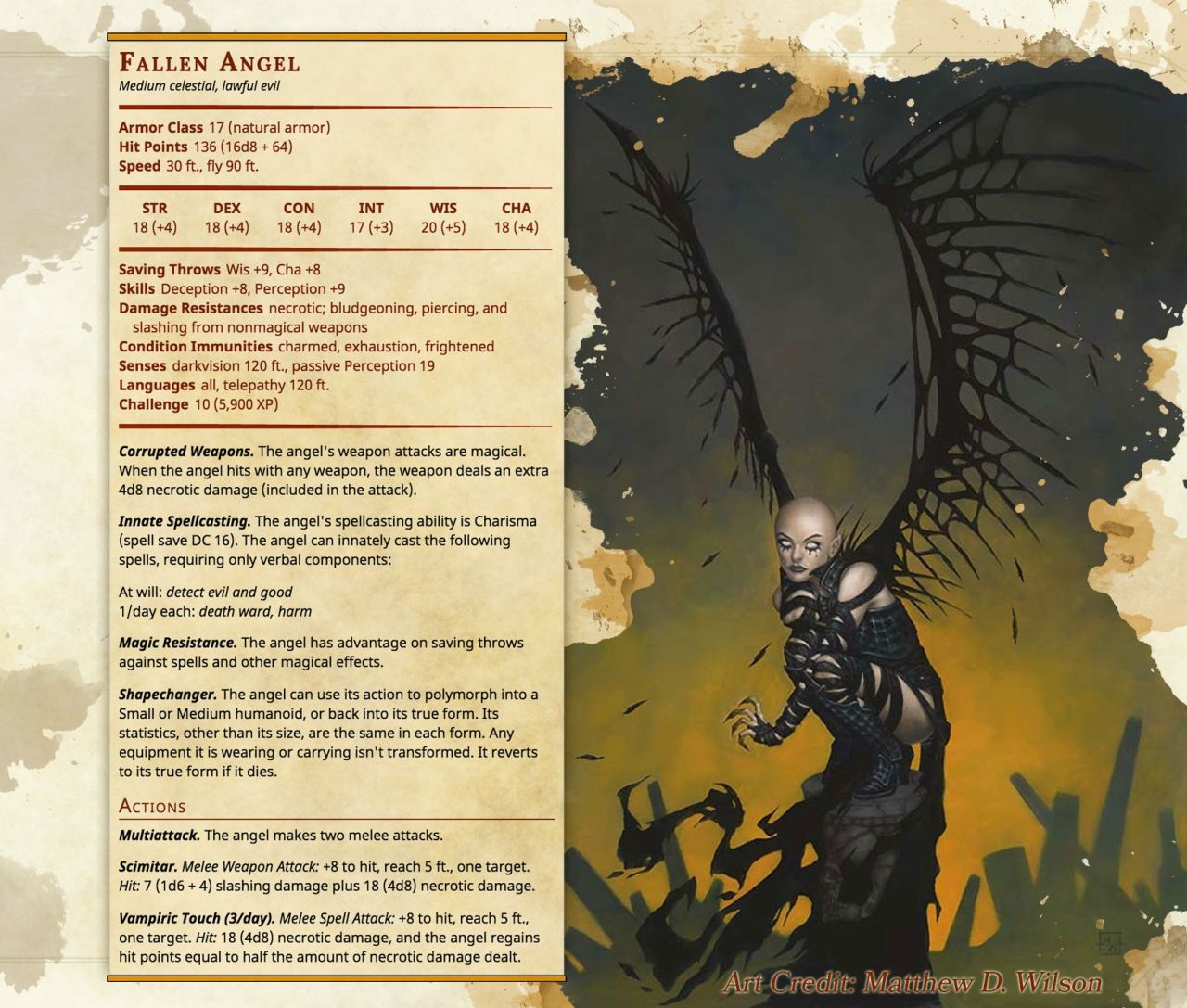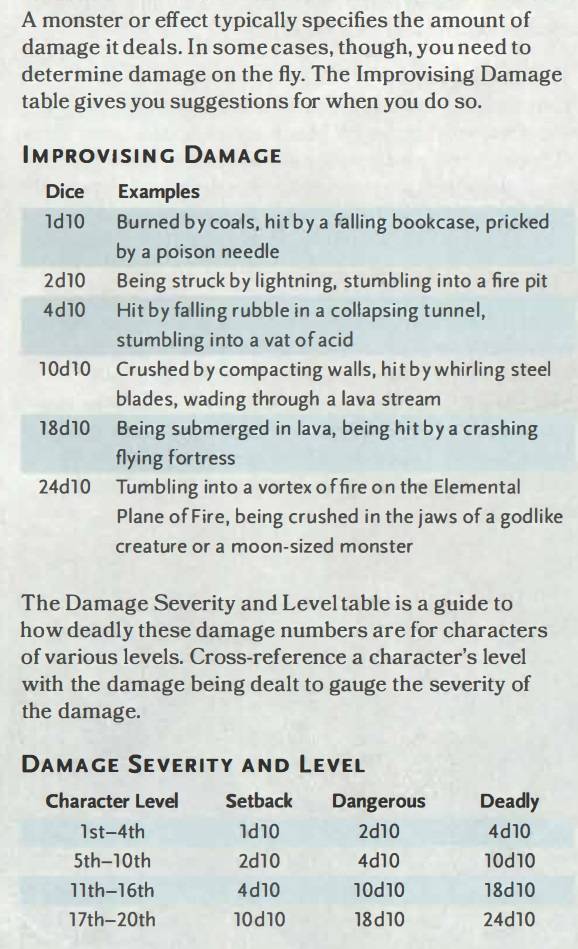
DnD 5e Fall Damage Explained The GM Says
Falling A fall from a great height is one of the most common hazards facing an adventurer. At the end of a fall, a creature takes 1d6 bludgeoning damage for every 10 feet it fell, to a maximum of 20d6. The creature lands prone, unless it avoids taking damage from the fall. Suffocating

D&D 5E Fall Damage / Quick And Simple Guide To D D 5e Damage Types The Alpine Dm / A dungeon
Fall Damage in 5E can be a confusing topic, but it will inevitably come up in most games at some point. So fear not, as this article will tell you all you need to know to decide whether your character twisted an ankle, or is now a high-level pancake.. How Fall Damage works. The rules for falling explain (PHB, p. 183): When a creature finishes falling they take 1d6 damage for every ten feet.

Fall Damage Dnd 5E Fall Damage Dnd 5E D D 5e House Rules Falling Dungeon
Posts: 728 https://www.dndbeyond.com/search?q=fall damage Even a blind squirrel finds a nut once in awhile. #3 Jan 9, 2018 Rhymfaxe Veteran Join Date: 8/10/2017 Posts: 26 You take 1d6 bludgeoning damage per 10ft fallen, up to a max of 20d6 (PHB p.183).

Fall Damage Dnd 5E D&D 5e Damage Types A Quick and Simple Guide The Alpine DM carolyncreative
In most cases, any fall you are likely to encounter in D&D will only last a round, given the tremendous damage that comes with falling more than 500 feet. that fall works out to about 83 feet per second. Is There Max Fall Damage? As mentioned above, there is a cap on the amount of bludgeoning damage you can take from a fall.
Fall Damage Dnd 5E Fall Damage 5E Acrobatics D D 5e Mystic Character Sheet Follow the
In DnD 5e falling can come from many things. You could drop through a trap door, or a spell could have elevated you and then dropped you, you may even have jumped off of a cliff and hurtled towards the ground. Regardless of the situation, it's good to know how to calculate and roll for falling damage. As I mentioned, it's very simple.
Fall Damage Dnd 5E Sometimes, applying damage to a creature is slightly more complicated
I finally understand falling damage. 5th Edition Since I began DMing D&D for my friends, there was one rule that always bugged me. Falling damage. Most precisely, the damage limit at 20d6/200 feet.. Some have more slanted to certain types of narratives (dnd 5e is great for larger-than-life, getting out of trouble, heroic stories, while say a.
Damage Estimate Dnd 5E Falling Damage for Dungeons & Dragons 5E YouTube Resistance and
Basic rules for fall damage 5e. According to the Player's Handbook, falling is a pretty simple affair. After falling, a creature takes 1d6 bludgeoning damage for every ten feet it fell. The creature becomes prone when they land unless they can avoid taking the fall damage altogether. The maximum damage a creature can take from a fall is 20d6.

Dnd 5E Falling Damage
Fall damage is a simple mechanic in DnD 5e, which comes with advantages and disadvantages. On the plus side, it's very easy for DMs to run and players to remember the rules. But this simplicity also creates such unrealistic scenarios that it sometimes breaks player immersion. We'll go over: How to calculate fall damage in 5e

Dnd Fall Damage 5E Fall Damage Dnd 5E / Path of the Reaper (DnD 5e For instance, a
In D&D 5e, "fall damage" translates to nonmagical bludgeoning damage, which is a type of damage that creatures can take in the game. When your PC takes fall damage, they lose hit points (HP). Hit points measure how much health your PC has.
5e Fall Damage Fall Damage Dnd 5e / 5ecreatureoc Usnea, The Fallen Leshay Dnd Ibrarisand
How to Calculate Fall Damage 5e Before we get into what to do when you find yourself falling, let's go over how fall damage actually works. To start with, here's the raw fall damage rules from the basic rules: " A fall from a great height is one of the most common hazards facing an adventurer.

Falling Damage for Dungeons & Dragons 5E YouTube
Apr 5, 2015 at 9:10 @doppelgreener I was not sure which edition the wiki page was for. My hope was with 5e baseline fall damage being a D6 that it was my most likely starting point for a house-rule. It is pretty much the only thing i have found that broke down objects like that. - Quiescat Apr 5, 2015 at 15:53 Add a comment 5 Answers Sorted by: 37

5e Fall Damage Fall Damage Dnd 5e / 5ecreatureoc Usnea, The Fallen Leshay Dnd Ibrarisand
The basic rule for fall damage in D&D 5e is that a character takes 1d6 points of damage for every 10 feet fallen, up to a maximum of 20d6. Some creatures or characters may have abilities, spells, or items that allow them to reduce or avoid fall damage.

Dnd 5E Falling Damage Transborder Media
How To Calculate Fall Damage. Based on the current version of Dungeons & Dragons, which is 5e, characters will take fall damage in batches of ten feet. After falling the first ten feet, a character has a chance to receive 1d6 of fall damage. Every additional ten feet adds another d6, for a maximum of 20d6. This has a max damage output of 120.

5E Fall Damage Resistance The Harder They Fall Revising Falling Damage For 5e / Damage
How does fall damage work in 5e? How is fall damage calculated in 5e? How much damage do you get from falling in 5e? Is there a cap on fall damage in 5e? How far do you fall per turn in 5e? What is the maximum speed you can fall in 5e? How do you calculate the damage of a falling object in 5e? Exceptions to the fall damage rules

Dnd 5E Falling Damage Transborder Media
Effects on the Game What does this change to falling damage mean for the game? Below are some examples of how this rule works, all assuming that the falling character has a Constitution score of 14 (which is, in my experience, fairly average).

Fall Damage Dnd 5E Snart? If a creature was to fall down a hole, or off a cliff, when it hit
Falling objects deal damage based on what kind of object tumbles toward the creature and how dangerous that object would be if it collided. Unlike previous editions, D&D 5e opts to provide Dungeon Masters with a couple of tables of examples instead of a formula that determines how much damage the object does when it collides with the target.